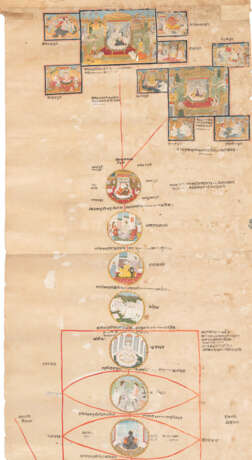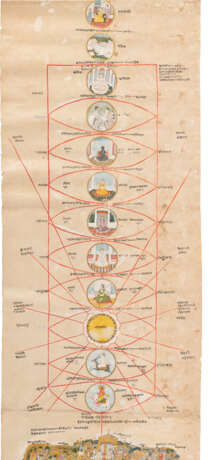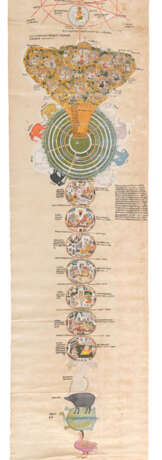ID 972883
Lot 1842 | Das brahmanische Universum
Valeur estimée
€ 15 000 – 25 000
360 x 57 cm
Die sehr seltene und feine Bildrolle zeigt das brahmanische („hinduistische“) Universum. Im Mittelpunkt ist die scheibenförmige mittlere Welt abgebildet, die aus sieben Kontinenten besteht. Im Zentrum dieser Welt befindet sich eine kreisförmige Landmasse, umgeben von sechs konzentrischen Kontinenten und Ozeanen. Aus dem Zentrum der Mittelwelt erhebt sich der mythische Weltenberg, der durch eine Aufschrift als „Kailash-Gebirge“ bezeichnet wird und dessen Höhe mit 900 Millionen yojana angegeben ist. Den Gipfel des Gebirges bedecken die Paläste der Götter, deren Namen in Aufschriften genannt werden. Am Rande der kreisförmigen Scheibenwelt sind die acht Elefanten der Weltgegenden (Sanskrit: aṣṭadiggaja) abgebildet, die in der hinduistischen Kosmologie als Hüter der Himmelsrichtungen die Mittelwelt tragen. Unterhalb der mittleren Welt sind die sieben Höllen übereinander angeordnet. Auf sieben ovalen Medaillons sind die Paläste der Höllenfürsten und ihre Bewohner abgebildet. Die zugehörigen Aufschriften benennen die Höllen und geben das Größenverhältnis an. Unterhalb der Höllen ist die vielköpfige Weltenschlange (Sanskrit: śeṣa oder ananta), gefolgt von dem mythischen Tieren Eber (Sanskrit: varāha) und Schildkröte (Sanskrit: kūrma), die der Überlieferung zufolge die Welt einst vor der Vernichtung durch Dämonen bewahrten. Eber und Schildkröte gelten als Manifestationen des Gottes Viṣṇu und die Weltenschlange ist Bestandteil der viṣṇuitischen Schöpfungsgeschichte, weshalb die Bildrolle vermutlich einem viṣṇuitischen Kontext zuzuordnen ist. Unterhalb der Schildkröte ist ein Vogel (Schwan oder Gans, Sanskrit: haṃsa) abgebildet, der als Tragtier des Schöpfergottes Brahmā die Erschaffung der Welt symbolisiert. Oberhalb des Weltenberges sind die Planeten abgebildet, ergänzt durch die 27 Mondstationen (Sanskrit: nakṣatra) der indischen Astrologie, die abgekürzt auf einer goldenen Blütenfläche eines Lotus aufgelistet sind. Oberhalb der Gestirne sind himmlische Ebenen mit den Palästen der Götter abgebildet.
| Catégorie maison de vente aux enchères: | Art asiatique |
|---|
| Catégorie maison de vente aux enchères: | Art asiatique |
|---|
| Adresse de l'enchère |
Nagel Auktionen GmbH Neckarstrasse 189 - 191 70190 Stuttgart Allemagne | ||||||||||||||
|---|---|---|---|---|---|---|---|---|---|---|---|---|---|---|---|
| Aperçu |
| ||||||||||||||
| Téléphone | +49 (0)711 649 690 | ||||||||||||||
| Fax | +49 (0)711 649 69696 | ||||||||||||||
| Commission | 29,5% | ||||||||||||||
| Conditions d'utilisation | Conditions d'utilisation | ||||||||||||||
| Heures d'ouverture | Heures d'ouverture
|







